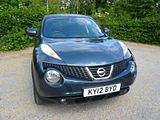
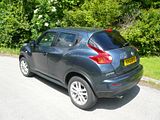
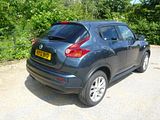

Many is the time that one hears the complaint that all cars look the same these days, and are hard to tell apart. That’s not an allegation that could be levelled at my most recent test car, as distinctive looks are very much one of the key selling propositions of the Nissan Juke. They are also bold looks, and when the production car was launched at the Paris Show in autumn 2010, there were plenty of comments both approving of and hating the styling. Look at the sales figures, though, and it is very clear that Nissan has achieved its objective as this car has sold very strongly across Europe, beating expectations. Now we’ve had time to get used to its looks, as the car is a common sight on our roads, it is easier to assess the vehicle more objectively and see what qualities it has beyond its appearance. Hertz UK took delivery of a large fleet of Juke models in early March, and my effort to sample one at that time failed as they quickly dispersed from base, but my luck was in with a recent need for a car to take me one way from Bristol to Heathrow. Or was it?



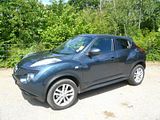
The Juke allocated to me was fitted with the 1.6 litre petrol engine, which develops 117bhp at 6000 rpm. On paper this suggests that it should compare well with the 1.5 diesel unit, which puts out 110bhp. Both of course are well beaten by the 190 bhp of the 1.6 litre Turbo engine that tops the range. Juke is offered with a choice of either a 5 speed manual or Nissan’s CVT automatic transmission. Top spec models with the 1.6 Turbo engine can be fitted with 4 wheel drive. I’m disappointed to have to report that the 1.6 litre petrol of the test car was the perfect example of what is wrong with almost all petrol engines in cars of this class. In the quest for optimum official CO2 emissions figures the engine has been emasculated to the point of making the car pretty joyless to drive. The engine is sluggish, seeming like at least half of those 117 horses are simply not there. It does liven up somewhat once you reach 4000rpm, but I suspect that most buyers are unlikely to appreciate that fact, as if they wanted a rev-happy car, they would probably not have selected a Juke in the first place. Unfortunately working the engine like this also adds to the not insignificant noise levels, the worst of which seemed to be a rather unpleasant drone at around 75 – 80 mph. I was not very impressed with the gearshift either. It is quite clunky, with a very short throw from first to second, but quite a wide gate over to the third/fourth plane. To get any form of acceleration out of the Juke you will need to use the gears quite a lot, so it is just as well that the lever falls nicely to hand The dynamics don’t get better when you consider other facets, either. In fact, they get worse. The steering was terribly vague, with far too much assistance meaning that there was precious little feel, there is a lot of body roll even on quite moderate bends and the brakes were simply mushy, needing a firm application on the pedal before you got the sensation that anything would happen. There is a conventional pull-up handbrake lever between the seats. At least the ride was quite good, with the Nissan absorbing the bumps and horrid road surfaces that constitute the British road network without undue difficulty. The Juke was economical, though, averaging 38.4 mpg whilst in my custody, which I thought was quite respectable considering how hard I had worked the engine to get some acceleration out of it. It did, though, have the benefit of some steady speed cruising down the M4 to compensate.
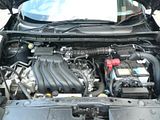
Prospective purchasers will doubtless be attracted to the Juke, among other reasons, because of its extra height, and the seating position which lifts your seating position that little bit higher than that enjoyed by many other road users. They had better check it out carefully, though. Visibility out of this car is not a universally strong point, with particularly thick C pillars which mean that there is a huge blind spot when reversing. Acenta Premium models do include a camera which projects a very clear view on to the satellite navigation screen which helps somewhat. The view straight ahead is much better, though the large area of the top of the headlights on the bonnet is something to which one would have to get used. The high sides and relatively shallow side windows don’t help much, either. Inside the car, the seat was decently comfortable, though the backrest adjuster is one which offers a series of steps rather than continuous adjustment, and my preferred angle of inclination was, predictably, between two notches. The seat was also too high for me. The interior of the Juke is more conventional in appearance than the outside, but even here it dares to be different, with styling themes which are supposed be reminiscent of a motor cycle. The dash moulding of the test car was a dark grey, with a sizeable gloss black insert in the centre of the dash, and then there is a large almost metallic look grey moulding around the centre console surrounding the gearlever and handbrake, which with its convex shape is supposed to remind the occupants of the fuel tank of a motor bike. This material also features on the door casing and the steering wheel hub, where you will also find door pulls which look like a large version of the ring-pull you get on a can. There are two fairly small dials set in their own aluminium-look casing with what looks like a floating lid acting as a cover over the top of them, apparently joined on by two struts. Thanks to the high seating position, you look down on the instruments, but even though they are smaller than in many cars they are easy to read. As well as the two conventional dials for speedometer and rev counter, there are digital bar charts to represent fuel level and water temperature. Chunky column stalks operate the indicators, wipers and lights. The centre of the dash contains the audio unit whose small buttons proved rather fiddly to operate. These surround the display screen used for satellite navigation and the images from the reversing camera. Below these are the controls for the climate control, which are somewhat stylised as well. There are repeater buttons on the steering wheel hub for some of the audio unit functions and the cruise control. The steering wheel was leather wrapped and was decent enough to hold. Although there are some hard plastics on the dash, the cabin appears well put together and looks like it ought to be durable.
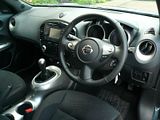
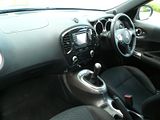
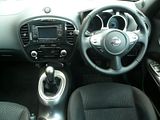
There is plenty of space inside the Juke, with generous levels of leg, knee and head room for rear seat passengers, thanks in part to the tall body styling. The boot does not initially appear to be that big, but this is deceptive, as there is a false floor fitted to make the bottom of the boot flush with the bumper line. With this in situ, and noting the all canvas parcel shelf which is attached to the tailgate of the car rather than the rear seats, the height appears quite limited, but look under the false floor and there is quite an additional deep area available. More space can be created by dropping down the asymmetrically split rear seat backrests which simply drop onto the rear seat cushions. Inside the passenger compartment, modest door bins are boosted by a very deep glovebox and a stowage recess in front of the gearlever.
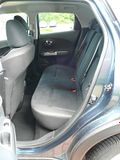
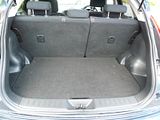

In Nissan speak, Acenta is a mid-spec trim level, positioned between the entry level Visia and sitting below the Tekna and Shiro. The Acenta brings with it 17″ alloy wheels, climate control, audio control repeaters on the steering wheel, bluetooth connectivity, cruise control with steering wheel mounted controls, front fog lights and body coloured mirrors and door handles. Upgrade to the Acenta Sport and you get that grey plastic moulding in the centre console (or red if you are feeling very brave!), a different alloy wheel design and rear privacy glass. The Acenta Premium adds the reversing camera and satellite navigation as well as 6 speakers for the audio unit. Spend more on a Tekna and you get leather seats auto sensing wipers and lights, heated seats and a “Stop/Start” button with Intelligent Key. The top spec Shira gives you two tone grey alloy wheels and some trim highlighting in the car which may or may not be to your taste. At £2,100 over the £15,595 that Nissan charge for a 1.6i 2WD Acenta Premium, I would say that the latter is rather better value for money.
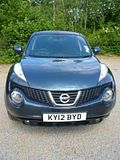
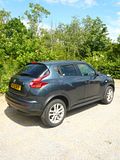

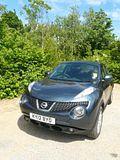
Overall, I have to confess to a huge disappointment with this car. Regardless of what you think of the styling, there were just so many minus points that this will be a contender for my “most disappointing car of the year” award. It’s not just me, either. When I was talking to the Hertz Bristol staff, they just rolled their eyes skywards and said that the petrol engined cars are really not good at all and they’ve had a lot of negative feedback. They also have some diesel powered models on fleet, and these do at least overcome the limitations of that engine and gearing, though whether the other dynamics are any better is unlikely. Given the unusual styling, which will be a real plus for some people, I can see that those who like the Juke for its looks could be attracted to it, though I suggest they try the diesel model, but for those who want a roomy small car that is taller than average, then I would guess (simply because I have yet to drive one) that a Yeti would be a far better bet.
2012-07-07 16:42:05






































